Atmospheric Pressure (AQA GCSE Physics): Revision Note
Exam code: 8463
The Atmosphere
The Earth's atmosphere is a thin layer (relative to the size of the Earth) of air around it
It exerts a pressure of about 100 kPa at sea level

The Earth's atmosphere
The atmosphere extends more than 100 km into space and becomes less dense with increasing altitude (height above sea level)
This means that the pressure becomes less too
Atmospheric pressure various slightly from day to day, depending on the weather, and fine clear weather is usually associated with high pressure
Atmospheric Pressure
The graph below shows how the pressure varies with altitude:

Graph of atmospheric pressure against altitude
Atmospheric pressure varies with height above a surface, for example, at sea level
This is due to air molecules colliding with a surface creating atmospheric pressure
These molecules create a force per area of the surface which creates the pressure
The number of air molecules (and so the weight of air) above a surface decreases as the height of the surface above ground level increases
This is also known as the density of the air
Therefore, as height increases, there is always less air above a surface than there is at a lower height and the atmospheric pressure decreases with an increase in height

Atmospheric pressure decreases as the density of the molecules decreases
Examiner Tips and Tricks
Explaining why atmospheric pressure decreases with increasing altitude is a common exam question - make sure you can summarise these points!

Unlock more, it's free!
Did this page help you?